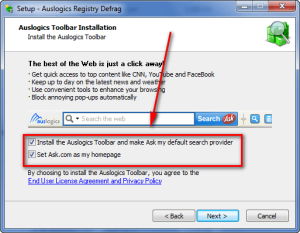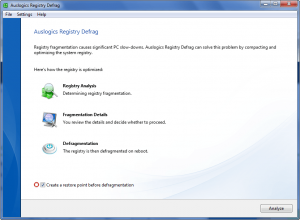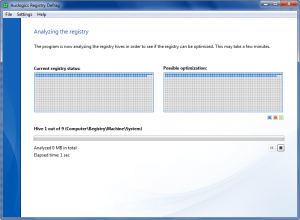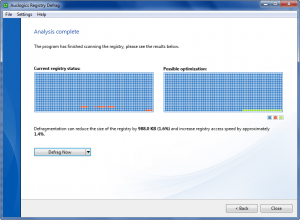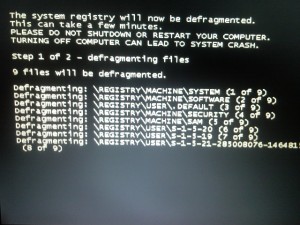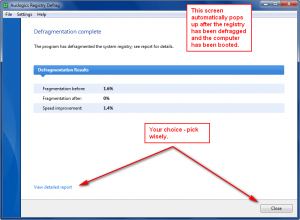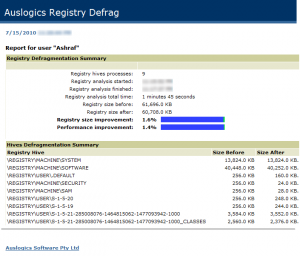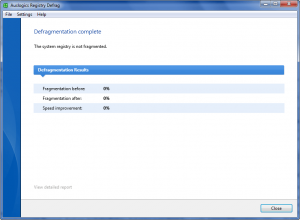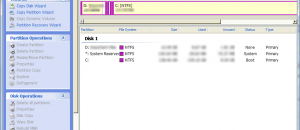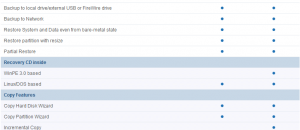{rw_text}Software reviewed in this article:
Version reviewed:
v6.0.3.30
Supported OS:
Windows 7/Vista/2008/XP/2003
Price:
$19.95 (USD)
Software description as per the developer:
Keeping the registry as compact as possible means better computer performance. Auslogics Registry Defrag is fast becoming an essential tool in keeping your registry defragmented. As a result, the Registry becomes compact and small, greatly improving your computer performance.
{/rw_text} –>
{rw_good}
- Straightforward and very easy to use.
- Allows users to perform analysis of registry before deciding if they want or need to defrag it.
- Users have the option to reboot computer immediately and defrag registry, or schedule a defrag to occur next time the computer is rebooted.
- Has the option to automatically create System Restore points before registry is defragged.
- Provides users with a detailed report after defragmentation has been finished.
{/rw_good} –>
{rw_bad}
- Nothing is really “wrong” with the program itself, as far as I can tell.
{/rw_bad} –>
{rw_score}
{for=”Ease of Use” value=”10″}Literally point and click; extremely easy to use.
{/for}
{for=”Performance” value=”10″}For being a registry defragger, Auslogics Registry Defrag performs well (probably one of the best registry defraggers out there), hence I give it a 10. However, the effectiveness of registry defraggers in general varies highly on a case-to-case basis.
{/for}
{for=”Usefulness” value=”3″}Registry defraggers really are not too useful; the performance gain they provide to your computer, if any at all, is often negligible.
{/for}
{for=”Price” value=”6″}For a standalone registry defragger, $19.95 is overpriced. In my opinion $14.95 is a better price for this software. In fact, I would even go as far to say standalone registry defraggers are worth no more than $10, but the extra $5 premium is tacked onto Auslogics Registry Defrag because it comes from a premium company.
{/for}
{for=”Final Score” value=”8″}
{/for}
{/rw_score} –>
{rw_badb}Auslogics Registry Defrag comes bundled with an Auslogics-branded Ask.com toolbar:
You can, of course, opt-out of installing the toolbar and making Ask.com your homepage but it makes me really sad that a commercial, paid software comes bundled with such things.
{/rw_badb} –>
{rw_verdict}[tupr]
{/rw_verdict} –>
As the name implies, Auslogics Registry Defrag is a registry defragmentation program. What exactly is registry defragmentation? Most of have heard of, and have performed, hard drive defragmentation before; registry defragmentation is a similar concept to hard drive defragging. To better understand what registry defragmentation is, lets first understand what hard drive defragmentation is.
Lets say you have a bookshelf that can hold up to 100 books. Over time you purchase books and place them on the bookshelf wherever you find space; in other words you are not very particular about putting the books in any specific order, like alphabetical order. As time goes on and your bookshelf gets filled, it becomes harder and harder for you to find a specific book because the books on the bookshelf are placed randomly (in no specific order). One day you are fed up with having to spend 10 minutes every time you need to find a book so you decide to alphabetize all your 100 books. Thus, you invest 30 minutes into properly alphabetizing all your books. After you have alphabetized the bookshelf, it becomes a lot easier and a lot quicker to find a specific book. Hard drive fragmentation and defragmentation is a similar concept.
Over time your hard drive gets fragmented as files are placed in the first open spot available; over time it starts to take longer and longer for your computer to find the specific file it needs because the files are in no specific order (figuratively speaking). When you defrag your hard drive, it is like alphabetizing your bookshelf: the files on the hard drive are put in order thus making it easier and quicker for Windows to find them when they are needed. The same thing (fragmentation) that happens to your hard drive happens to the registry, but on a smaller scale.
Lets say now instead of 100 books, you only have 5 books. Yes, it does require less effort and time to find a specific book if the 5 books are in alphabetical order as opposed to being in a random order, but the amount of effort and time saved is negligible because there are only a small number of books to deal with. This, in simplistic terms, describes the similarities and differences between hard drive fragmentation and registry fragmentation. With hard drives being hundreds of gigabytes big, fragmentation can really hurt performance, hence why defragging the hard drive often results in a noticeable performance increase (however, it does vary on a case-to-case basis, depending on how fragmented your hard drive is). Registries, on the other hand, are not nearly as large as hard drives. Yes, defragging them may increase performance, but the performance increase is often negligible.
There is, however, one extra benefit to defragging registries not depicted in the analogy above. When Windows is running, the registry is loaded into your RAM. So, when you defrag the registry, you make it smaller (how much smaller depends on how large and fragmented the registry was to begin with); when your registry is smaller, it will take up less space when loaded into your RAM. Don’t get your hopes but, though – the amount of RAM recovered by having a smaller registry does not amount to a whole lot of RAM because the registry is often only compacted a few MB, if any at all.
To summarize, yes defragging the registry will result in performance increase (if you do the defragging with quality software which won’t implode your computer) but the performance increase is not that much. More often than not, people with older, weaker machines will benefit more from registry defraggers than people with newer, more powerful machines (because newer computers typically have increased computing power making the performance increase gained from a defragged registry all the more negligible). But even people with older, weaker machines shouldn’t expect miracles, because defragging the registry won’t deliver any.
That said, Auslogics Registry Defrag is one such “quality software” I referred to in the last paragraph – it is easy to use (in fact very easy to use), and defrags the registry quickly, safely, and completely. If you do decide you want a registry defragger, Auslogics Registry Defrag will grind out the most performance increase one can receive from registry defragmentation.
Using Auslogics Registry Defrag is very, very easy:
- Step 1 – Run the program
(Take note of the option that automatically creates a System Restore point before defragmentation.)
- Step 2 – Analyze the registry
- Step 3 – Read the analysis report and decide if your registry is fragmented enough for you to defrag
- Step 4 – Select when you want to defrag the registry (if you don’t want to defrag the registry, just close the program) – right now, or during next computer reboot:
(Screenshot clipped from the developer’s website.)
If you select to defrag now, your computer will be rebooted and the defragmentation will occur during reboot. If you select to defrag later, defragmentation will be scheduled to occur during the next time you reboot your computer. (Defragmentation occurs during reboot and not while Windows is running because programs use the registry while Windows is running and compacting the registry at that time is darn, right hard.)
- Step 5 – Defrag the registry (you don’t need to do anything except reboot your computer)
- Step 6 – Read the detailed report (or, you can just click “Close” if you won’t want to read the report)
You can of course run Auslogics Registry Defrag as many times you want and defrag your computer’s registry whenever you want. However, don’t run Auslogics Registry Defrag too many times, too quickly because if the registry is not fragmented, you will be turned away and told there is nothing to defragment:
In terms of performance, Auslogics Registry Defrag is one of the best. As I already mentioned, Auslogics Registry Defrag works very quickly, and defrags the registry very well, and is a fairly safe program. In fact, Auslogics Registry Defrag is so good in its class that I don’t have anything “bad” to say about it (which is a first, since I always have something to say) except that it is a bit overpriced. (Oh, and I am very unhappy with the Ask.com toolbar that comes bundled with Auslogics Registry Defrag, but that is another issue and not directly related to the program itself like performance and price are.)
This review was conducted on a laptop running Windows 7 Professional 32-bit. The specs of the laptop are as follows: 3GB of RAM, a Radeon HD 2600 512MB graphics card, and an Intel T8300 2.4GHz Core 2 Duo processor.
{rw_freea}
All the of following are either standalone registry defrag software, or are system utilities that have a registry defrag component to them:
- WinUtilities Professional Edition
- Glary Utilities
- Eusing Free Registry Defrag
- Wondershare Registry Defrag
- …and there are many more out there (share in comments below if you know of them).
{/rw_freea} –>
{rw_verdict2}Without a doubt Auslogics Registry Defrag is one of the best registry defraggers out there; thumbs up and recommended to those that need or want it. However, in the end, the quality of the software may be excellent but it is still a registry defragger, something most people shouldn’t have the need for.
{/rw_verdict2} –>

 Email article
Email article
